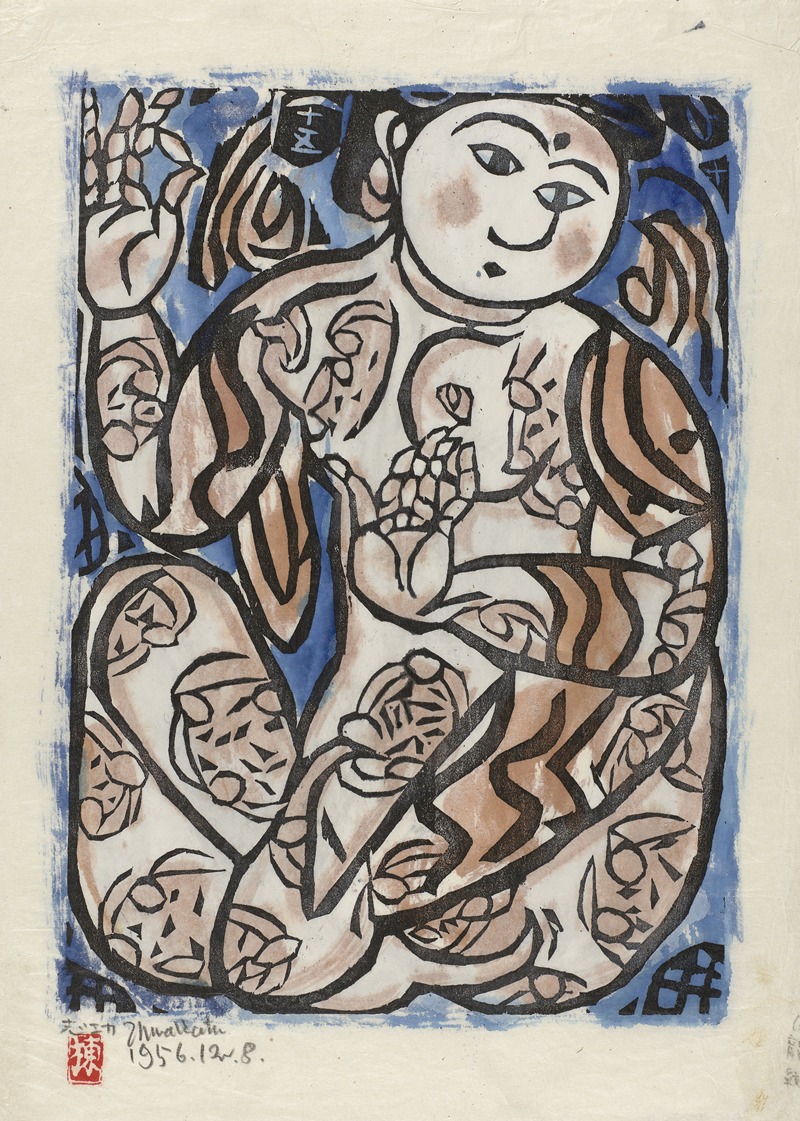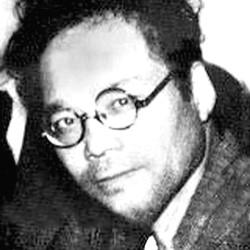

Munakata Shikō was a woodblock printmaker active in Shōwa period Japan. He is associated with the sōsaku-hanga movement and the mingei (folk art) movement. Munakata was awarded the "Prize of Excellence" at the Second International Print Exhibition in Lugano, Switzerland in 1952, and first prize at the São Paulo Bienal Exhibition in Brazil in 1955, followed by Grand Prix at the Venice Biennale in 1956, and the Order of Culture, the highest honor in the arts by the Japanese government in 1970.
Munakata was born in the city of Aomori in Aomori Prefecture in northern Honshū as the third of 15 children to a local blacksmith. Due to the impoverished circumstances of his family, he had only an elementary school education; however, he exhibited a passion for art from early childhood. In third grade, he began illustrating kites for his classmates.
Munakata later claimed that his artistic endeavors were sparked by Vincent van Gogh's (1853–1890) Still Life: Vase with Five Flowers, a reproduction of which was given to him by his teacher when he was 17. Upon viewing of van Gogh's artwork, young Munakata decided that he wanted to become the “van Gogh of Aomori”. In 1924, Munakata moved to Tokyo in order to fulfill his decision to become a professional painter in oils.
Munakata's early career was not without obstacles. Unable to sell his paintings, he was forced to repair shoes and sell nattō part-time to survive. He was rejected by the Bunten (The Japan Art Academy Exhibition) four times, until one of his paintings was finally accepted in 1928. However, by this date, his attention had shifted away from oil painting to the traditional Japanese art of woodblock printing.
In 1926, Munakata saw Kawakami Sumio's black-and-white woodcut Early Summer Breeze, and decided to work on black-and-white prints. From 1928 onwards, Hiratsuka Unichi (1895–1997), another renowned sōsaku-hanga printmaker, taught Munakata wood carving. In 1929, four of his prints were accepted by the Shunyokai Exhibition, which bolstered his confidence in the new medium. In the following year, four more of his works were accepted for the Kokugakai national exhibition, thus establishing him in his career. His work was also part of the art competitions at the 1932 Summer Olympics and the 1936 Summer Olympics.
In 1935, Yanagi Sōetsu (1889–1961), father of the mingei (folk art) movement, saw Munakata's prints at the Kokugakai's annual spring exhibition, and bought twenty-five prints of Yamato shi Uruwashi by Munakata. This event changed Munakata's life. From then on Munakata was closely associated with the Japanese folk art movement. In 1936, Munakata went to Kyoto and visited many Buddhist temples and saw many sculptures. Munakata's exposure to Buddhist religious imagery influenced his artistic style significantly. Ten Great Disciples of the Buddha (1939) is considered to be his greatest masterpiece.
Munakata's house and most of his woodblocks were destroyed in the American firebombing of Tokyo in May 1945 his pet was also killed. He relocated to Fukumitsu Town, Toyama Prefecture from 1945-1951.
After World War II, Munakata produced numerous woodblock prints, paintings in watercolor and oil, calligraphy, and illustrated books. He moved his studio to Kamakura in Kanagawa to be closer to Tokyo. He traveled overseas to the United States and Europe in 1959, giving lectures at a number of overseas universities. His works received critical acclaim both in Japan and overseas, and he received many prizes.
Munakata was awarded the "Prize of Excellence" at the Second International Print Exhibition in Lugano, Switzerland, in 1952, and first prize at the São Paulo Bienal Exhibition in Brazil in 1955, followed by Grand Prix at the Venice Biennale in 1956. He was awarded the Order of Culture, the highest honor in the arts, by the Japanese government in 1970.
Munakata died at his home in Tokyo. His grave is in Aomori, and his gravestone is patterned after that of Vincent van Gogh.

